To make a candy sorting party educational, set up a safe and organized station with clear containers, choosing colorful candies like Skittles or M&Ms for ease. Incorporate learning goals like counting, pattern recognition, and sensory sorting by asking kids to categorize by color, flavor, or texture. Add creative challenges, teamwork activities, and discussion topics like packaging design or candy history to deepen engagement. Continue exploring these ideas to turn the activity into a fun, skill-building experience.
Key Takeaways
- Use clear containers and safe, accessible setup to create an organized, hygienic candy sorting environment for kids.
- Incorporate educational elements like counting, pattern recognition, and color sorting to develop math and visual skills.
- Add sensory activities such as sorting by smell, texture, or sound to deepen engagement and expand learning beyond visuals.
- Foster teamwork with group roles, shared goals, and fun challenges to promote cooperation and social skills.
- Extend learning through discussions on candy history, packaging design, and related creative projects for a lasting educational impact.
Setting Up a Fun and Safe Candy Sorting Station
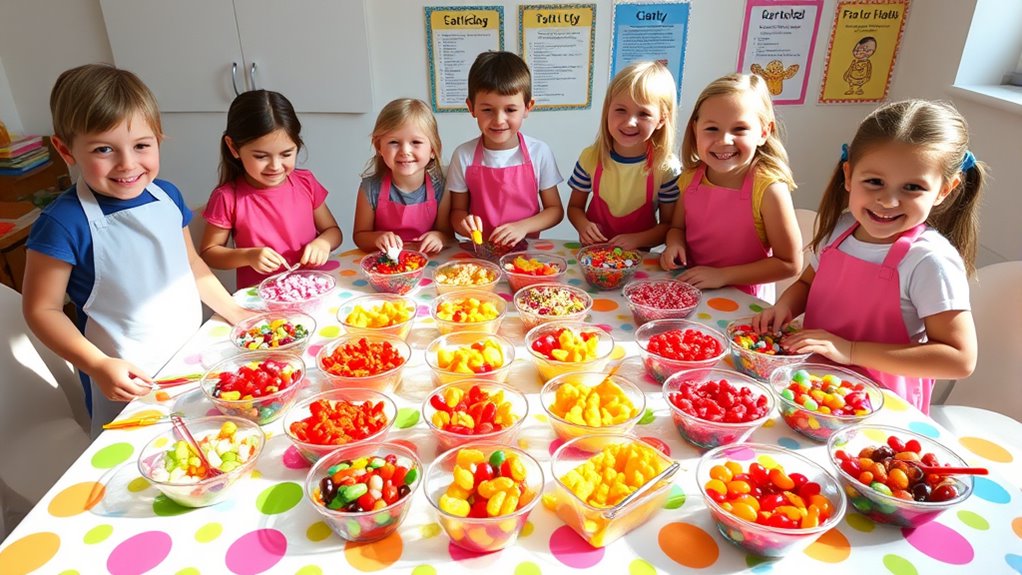
To guarantee the candy sorting activity is both fun and safe, start by setting up a designated station that’s organized and accessible. Choose a sturdy table with enough space for kids to spread out their candies comfortably. Ensure the candies are stored safely in clear, sealed containers to prevent spills or contamination. Pay attention to candy texture—some candies might be sticky or fragile, so handle them gently to avoid messes or breakage. Keep small candies away from very young children to prevent choking hazards. Place wet wipes, napkins, and hand sanitizer nearby to promote good hygiene. Clear labels help kids identify different candies easily. A well-organized, safe setup encourages kids to enjoy the activity while minimizing risks related to storage safety and candy texture. Remember to regularly inspect the setup and safety protocols to ensure ongoing safety throughout the event.
Choosing the Right Types of Candy for Sorting Activities
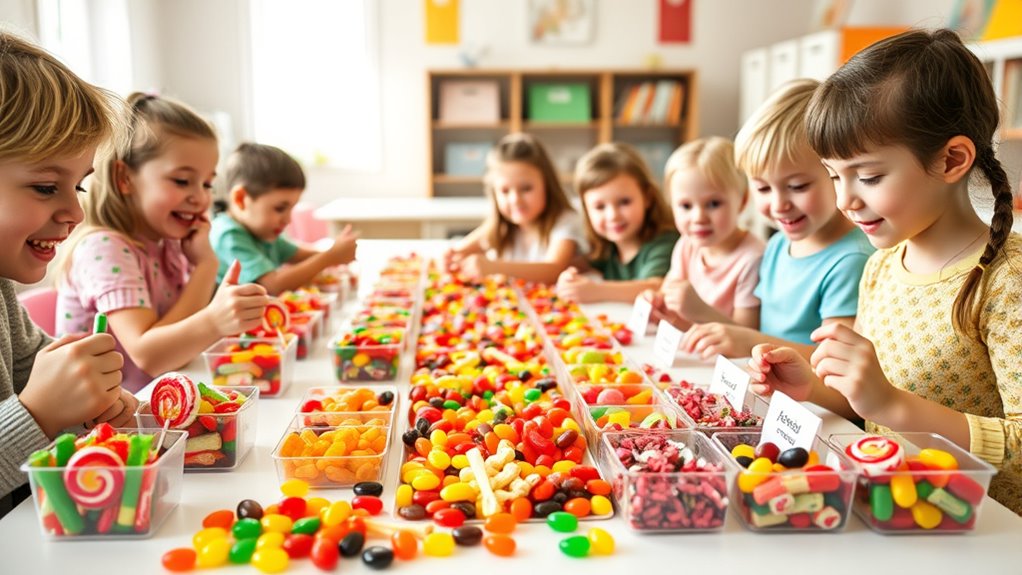
Choosing the right types of candy for sorting activities is essential to guarantee kids stay engaged and have a positive experience. Select candies with diverse flavors and packaging styles to make sorting fun and educational. For example, using candies like M&Ms, Skittles, and Reese’s provides variety in both flavor and appearance. Consider candies that are easy to handle and distinguish, such as individually wrapped or unwrapped options. Here’s a quick comparison:
| Candy Type | Packaging Style | Flavor Variety | Ease of Sorting | Visual Appeal |
|---|---|---|---|---|
| M&Ms | Wrappers | Chocolate, Peanut | Easy | Colorful |
| Skittles | Loose or Packaged | Fruit flavors | Easy | Bright colors |
| Reese’s | Individually wrapped | Peanut butter | Moderate | Recognizable |
Using these types ensures kids can practice categorization effectively while enjoying the game. Additionally, choosing candies with distinct visual features can help children develop better sorting skills.
Incorporating Educational Goals Into Your Candy Game
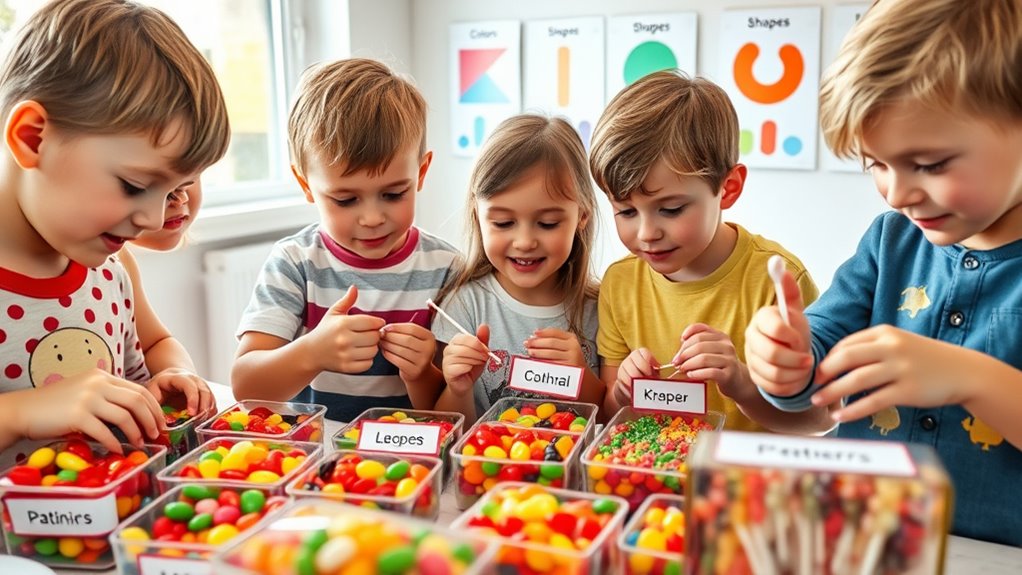
You can turn your candy game into a fun learning experience by focusing on math skills like counting and recognizing patterns. Incorporate color recognition by asking kids to sort candies by shades or create color sequences. These activities help children develop essential skills while they enjoy the game. Additionally, you can introduce concepts of exfoliation to explain how removing dead skin cells can lead to healthier skin, making the learning experience more comprehensive.
Math in Candy Sorting
Incorporating math into your candy sorting game makes learning both fun and meaningful. You can challenge kids to count, categorize, and compare candies based on various factors. For example, sorting by sugar types like gummy, chocolate, and hard candies helps develop classification skills. You can also introduce candy branding, encouraging kids to identify and group candies from different brands. To add structure, create a chart like this:
| Candy Type | Brand A | Brand B | Brand C |
|---|---|---|---|
| Gummy | 3 | 2 | 4 |
| Chocolate | 5 | 3 | 2 |
| Hard Candy | 4 | 4 | 1 |
| Lollipops | 2 | 3 | 5 |
| Chewy | 3 | 2 | 3 |
This setup encourages counting, comparison, and pattern recognition. Engaging in organized activities like candy sorting can also support developing a sense of order and structure in learning.
Color Recognition Skills
Introducing color recognition into your candy sorting game is a fun way to enhance children’s visual discrimination skills. As they sort candies by hue, you can add nerdy trivia about color origins or how certain flavors are associated with specific colors. This encourages not only visual skills but also engaging conversations. Incorporate flavor analysis by asking kids to describe the taste differences between candies of similar colors, strengthening their sensory awareness. You might challenge them to identify the most common colors or to match candies to their respective colors based on packaging or branding. This approach makes learning playful and interactive, helping kids develop a keen eye for color while expanding their knowledge through fun facts and flavor comparisons. Additionally, discussing the color psychology behind certain hues can introduce children to basic concepts of visual perception and emotional associations with colors.
Counting and Patterns
Adding counting and pattern activities to your candy sorting game can make learning both fun and educational. As kids sort candies by texture and flavor variety, encourage them to count each group, reinforcing number recognition. Challenge them to create patterns with different candies—alternating textures like chewy, crunchy, and smooth, or flavor varieties such as fruity, chocolate, and caramel. This not only boosts their pattern recognition skills but also improves their ability to categorize and compare. You can ask questions like, “Can you make a pattern with three different textures?” or “How many candies of each flavor do you have?” These activities turn simple sorting into a hands-on lesson in counting, sequencing, and recognizing repeating patterns, making the game engaging and educational. Incorporating color contrast considerations can also enhance visual differentiation between candy types, aiding in pattern recognition and sorting accuracy.
Creative Variations to Enhance Sorting Challenges

To make sorting activities more engaging, try creating themed challenges that require kids to sort candies by specific attributes, like color, shape, or flavor. Incorporate creative variations such as sensory sorting, where kids use their sense of touch, smell, or even sound to identify and categorize candies. For example, you could ask children to sort candies by texture—smooth or bumpy—or by scent, distinguishing fruity from chocolatey smells. These variations challenge kids to think beyond visual cues and develop their sensory awareness. By mixing traditional sorting with sensory elements, you keep the activity dynamic and stimulating. Additionally, focusing on vibrational energy can help children feel more positive and engaged during the activity, making it even more enjoyable. Creative variations encourage kids to explore different attributes and make the candy sorting party both educational and fun.
Tips for Engaging Kids and Encouraging Teamwork
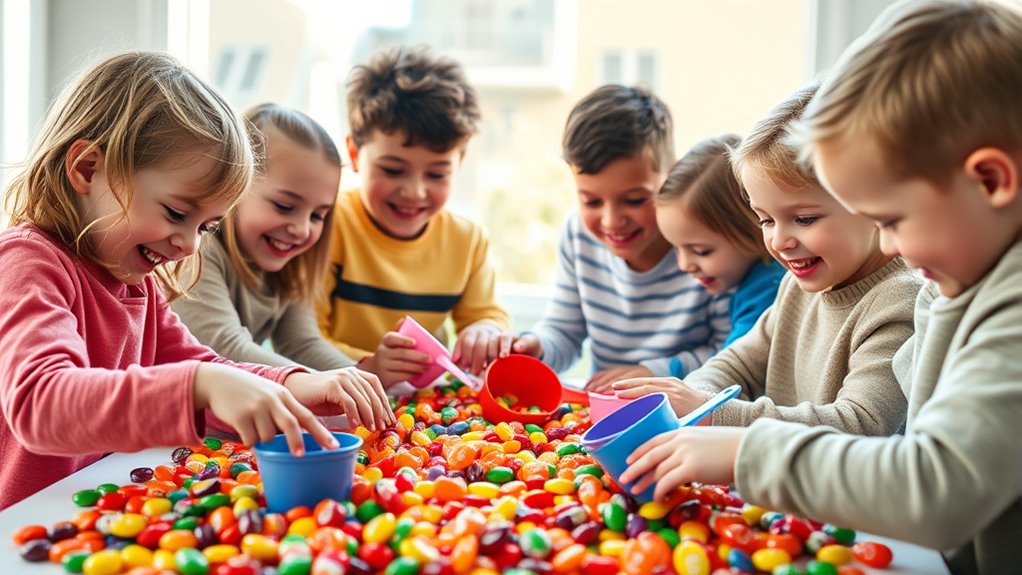
To keep kids engaged and foster teamwork, assign clear roles so everyone knows their part. Incorporate fun challenges that motivate cooperation and make the activity exciting. By setting shared goals, you encourage kids to work together and build a sense of accomplishment. Creating a welcoming and cozy bedroom environment can also help children feel more comfortable and open to participating actively.
Clear Role Assignments
Assigning clear roles from the start helps kids understand their responsibilities and stay engaged. When you pair candy types, such as chocolates with gummies, you can assign roles based on these groups. For example, one child can be responsible for sorting chocolates, while another handles gummies. This way, kids know exactly what they need to do and can focus on their task without confusion. By assigning roles early, you encourage teamwork and make the activity more organized. It also helps prevent disagreements and ensures everyone feels included. Keep roles simple and specific, and explain their importance. When kids understand their part in the process, they’re more likely to participate enthusiastically and work efficiently together. Incorporating sorting techniques can further streamline the activity and enhance learning.
Incorporate Fun Challenges
Adding fun challenges to your candy sorting activity keeps kids excited and motivated. You can create games like identifying candy flavors or sorting by packaging variety under time limits. These challenges boost engagement and teamwork while making the activity educational. To add variety, try this sorting table:
| Candy Type | Flavor Challenge | Packaging Variation |
|---|---|---|
| Gummy Bears | Guess flavor without tasting | Sort by wrapper design |
| Chocolate Bars | Match flavor to picture | Arrange by size |
| Lollipops | Identify flavor by smell | Group by packaging color |
These challenges encourage kids to observe carefully, work together, and learn about different candy characteristics, making your party both fun and instructive. Incorporating specialty teas into themed activities can introduce children to new flavors and cultural traditions, making the experience even more educational.
Promote Cooperative Goals
Encouraging kids to work together during the candy sorting activity transforms it from a simple task into a fun team effort. To promote cooperative goals, assign small groups to sort candies by color or type, emphasizing teamwork over competition. Incorporate party favors like stickers or mini toys to motivate collaboration, making the process more engaging. As kids work on candy packaging, encourage them to share ideas and divide responsibilities, fostering communication and cooperation. Set a shared goal, such as creating beautifully sorted candy bags or themed party favors, to give everyone a sense of purpose. Recognizing each child’s contribution boosts morale and reinforces the importance of working together. Understanding how teamwork influences successful projects can help children develop essential social skills. This approach turns candy sorting into an educational, collaborative experience that kids will enjoy and learn from.
Extending the Learning Beyond the Party
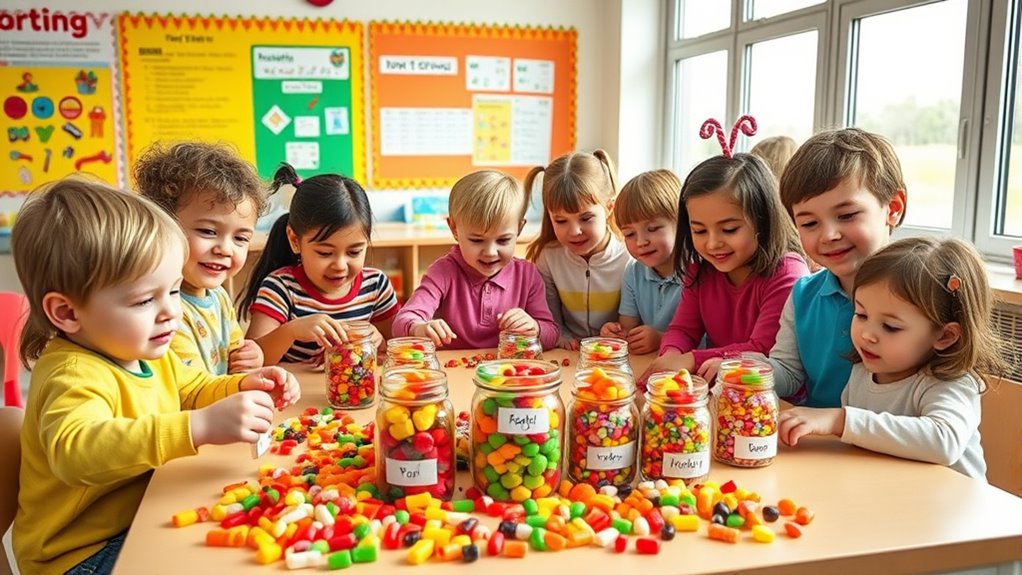
To extend the learning beyond the party, you can incorporate fun activities and discussions that reinforce the concepts of sorting and categorizing. Talk about candy history, exploring how different candies originated and evolved over time. This can spark curiosity about cultural traditions and innovations in confectionery. You can also examine candy packaging, encouraging kids to compare designs, materials, and branding. Discuss how packaging helps keep candies fresh and attracts buyers, linking it to marketing lessons. These conversations deepen understanding of categorization, while connecting it to real-world applications. Encourage kids to research their favorite candies or design their own packaging concepts, blending learning with creativity. Incorporating visual aids such as photos and examples can help solidify their understanding of the concepts. This approach makes the educational experience relevant and memorable, extending the benefits of the party into everyday knowledge.
Frequently Asked Questions
How Can I Adapt the Activity for Children With Allergies?
You can adapt the activity for children with allergies by offering allergy-friendly alternatives like dairy-free, gluten-free, or nut-free candies. Make safety modifications by clearly labeling all candies and keeping allergen information accessible. Encourage children to bring their own safe treats if needed. Guarantee a clean workspace and supervise closely to prevent cross-contact. This way, everyone can enjoy sorting candies safely and inclusively.
What Are Some Inexpensive Ideas for DIY Candy Sorting Tools?
Imagine turning everyday treasures into sorting tools. You can create DIY utensil ideas using recycled containers like small jars or cardboard boxes, perfect for sorting candies. Use plastic spoons or small scoops made from repurposed materials for easy handling. These recycled container options not only save money but also teach kids about sustainability. With a little creativity, you turn simple items into educational, fun tools that make candy sorting exciting and eco-friendly.
How Do I Handle Potential Messes During the Activity?
To handle potential messes, start with cleaning tips like keeping a damp cloth nearby for quick spills. Use mess prevention strategies by laying down a plastic tablecloth or old newspapers to catch stray candies and crumbs. Encourage kids to sort candies gently and provide small bowls or containers to minimize spills. Staying organized and proactive helps keep the activity fun and tidy, ensuring everyone enjoys the candy sorting without worry.
What Safety Precautions Should I Consider for Young Children?
You should prioritize child supervision at all times to guarantee safety during the activity. Investigate allergy awareness by checking for common allergies in candies and communicating with parents beforehand. Keep a close eye on kids to prevent choking or other accidents, and have allergy-friendly options available. Make sure the workspace is clean, and supervise children closely, especially when handling small candies, to create a safe, fun, and educational environment.
How Can I Include Non-Candy Items in the Sorting Game?
To include non-candy items in your sorting game, you can add non-food alternatives like small toys, stickers, or colorful erasers. These sorting non-food options make the activity more engaging and educational. Encourage kids to categorize by color, shape, or type, helping them develop sorting skills while having fun. Mixing in non-candy items broadens the activity, making it inclusive and perfect for teaching kids about sorting and categorization.
Conclusion
Hosting a candy sorting party isn’t just fun — it boosts kids’ sorting and categorization skills, with studies showing such activities can improve early math abilities by up to 30%. By creating a safe, engaging environment and adding creative challenges, you turn a simple game into a valuable learning experience. So, gather your candies, get creative, and watch kids develop essential skills while having a blast. It’s a sweet way to make learning both fun and memorable!









